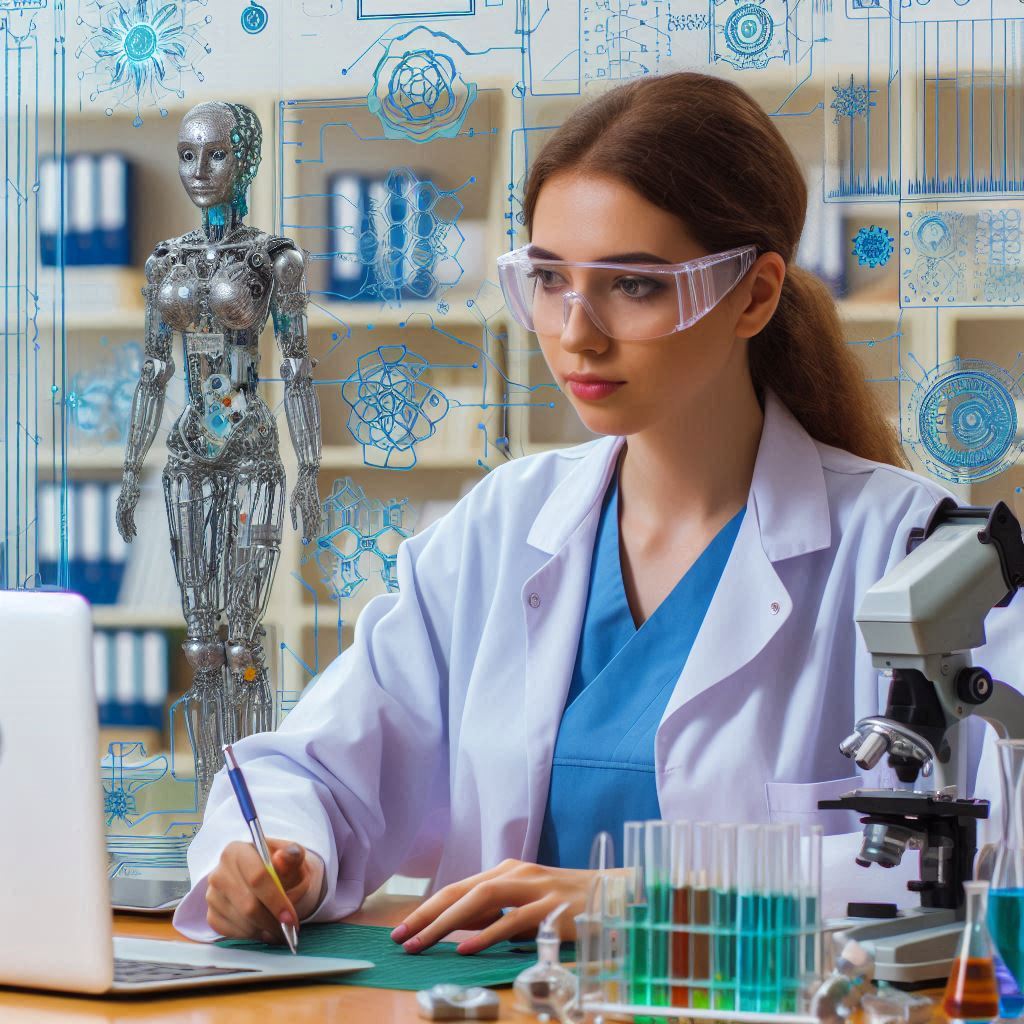Introduction
Biomedical engineering merges engineering principles with medical sciences to improve healthcare.
This field designs and develops medical devices, systems, and technologies.
Biomedical engineers work to create solutions that enhance the quality of patient care.
They integrate knowledge from various disciplines to tackle complex medical challenges.
Biomedical engineering plays a crucial role in modern healthcare.
It helps develop advanced diagnostic tools, therapeutic devices, and rehabilitation technologies.
These innovations improve patient outcomes and make healthcare more effective.
For instance, modern prosthetics and implants restore functionality and improve the quality of life for many individuals.
Diagnostic imaging systems, such as MRI and CT scans, provide detailed insights into medical conditions, enabling precise treatment.
Emerging trends are shaping the future of biomedical engineering.
Advances in artificial intelligence (AI) and machine learning are revolutionizing medical diagnostics.
AI algorithms analyze medical data more quickly and accurately than ever before.
This helps in early disease detection and personalized treatment plans.
Another significant trend is the development of wearable health technology.
These devices monitor vital signs in real-time and provide continuous health data.
Wearables can track everything from heart rate to glucose levels, helping manage chronic conditions more effectively.
They empower patients to take an active role in their health management.
Artificial Intelligence and Machine Learning in Biomedical Engineering
Overview of How AI and ML Are Revolutionizing Diagnostics and Treatment
Artificial Intelligence (AI) and Machine Learning (ML) are transforming biomedical engineering by enhancing diagnostics and treatment.
These technologies process vast amounts of data to reveal patterns and insights that human eyes might miss.
AI and ML algorithms analyze medical images, electronic health records, and patient data to provide more accurate and timely diagnoses.
They improve treatment plans by personalizing them based on individual patient information, which leads to better outcomes and more efficient care.
Examples of AI Technologies Being Used in Healthcare
AI technologies are making significant strides in healthcare.
Deep learning models now analyze X-rays and MRIs to detect conditions like cancer and fractures with high precision.
ML algorithms sift through electronic health records to predict patient risks and suggest treatments.
AI-powered chatbots and virtual assistants handle routine medical inquiries and facilitate remote consultations, freeing healthcare professionals to focus on more complex cases.
In drug discovery, AI models identify potential drug candidates faster than traditional methods.
Robotic surgery, enhanced by AI, performs delicate procedures with high precision and minimal invasiveness.
Potential Future Applications in Biomedical Engineering
Looking ahead, AI and ML are poised to further revolutionize biomedical engineering.
Future applications may include advanced diagnostic tools that integrate various data sources for more comprehensive analysis.
Wearable devices equipped with AI could provide real-time health monitoring and continuous insights.
ML models might predict disease outbreaks by analyzing global health data trends, leading to better preventive measures.
AI could also drive advancements in personalized medicine by integrating genetic, environmental, and lifestyle data to create highly customized treatment plans.
Additionally, AI may enhance regenerative medicine by analyzing cellular responses to different therapies, supporting tissue and organ regeneration.
Essentially, AI and ML are at the forefront of innovations in biomedical engineering.
They improve diagnostics, personalize treatments, and accelerate drug discovery, with promising future applications that will continue to advance patient care.
3D Printing in Biomedical Engineering
How 3D Printing is Transforming the Production of Medical Devices
3D printing, or additive manufacturing, is revolutionizing medical device production.
This technology builds objects layer by layer from a digital model.
Unlike traditional methods, 3D printing offers unparalleled flexibility and precision.
Engineers can create complex, customized structures that were once impossible or costly to manufacture.
By using 3D printing, medical devices can be produced more rapidly and with greater accuracy, reshaping the landscape of medical technology.
The Benefits of Using 3D Printing in Customized Implants and Prosthetics
The benefits of 3D printing in customized implants and prosthetics are substantial.
This technology enables the creation of highly personalized medical solutions tailored to individual patients.
Surgeons can design implants that fit perfectly with a patient‘s unique anatomy, leading to improved surgical outcomes and faster recoveries.
Custom prosthetics can be made to meet the specific needs and preferences of each patient, enhancing comfort and functionality.
3D printing also allows for quick prototyping and iterative design, which is crucial for effective medical solutions.
Challenges and Limitations of 3D Printing in Healthcare
Despite its advantages, 3D printing faces several challenges and limitations in healthcare.
One major issue is the regulatory approval process.
Medical devices must meet stringent safety and efficacy standards, which can delay the adoption of new 3D-printed technologies.
Additionally, the materials used must be biocompatible and durable, and not all materials currently meet these requirements.
The cost of high-quality 3D printing equipment and materials can be prohibitive, limiting access for some institutions.
Skilled operators and designers are needed to use this technology effectively, adding to the overall cost.
Long-term studies are also required to ensure the safety and effectiveness of 3D-printed medical devices.
Despite these hurdles, ongoing advancements in 3D printing are likely to address these issues, continuing to transform medical device manufacturing and patient care.
Read: From Intern to Lead: Climbing the Software Ladder in the US
Nanotechnology in Biomedical Engineering
Overview of How Nanotechnology is Being Used in Drug Delivery Systems
Nanotechnology is transforming drug delivery systems in biomedical engineering.
This technology involves manipulating materials at the atomic or molecular level.
The primary goal is to enhance the precision and effectiveness of medical treatments.
Nanoparticles are increasingly used to deliver drugs directly to targeted cells.
This approach reduces side effects and improves therapeutic outcomes.
For example, liposomes are spherical nanoparticles that transport drugs to specific tissues.
They ensure that drugs concentrate at the disease site, minimizing the need for high doses.
Examples of Nanomaterials Used in Medical Devices
Nanotechnology is also revolutionizing medical devices through the integration of advanced nanomaterials.
Carbon nanotubes are a notable example.
Their strength and flexibility make them ideal for creating advanced prosthetics and high-performance sensors.
These sensors can detect disease markers with remarkable accuracy.
Nanoscale coatings are another innovation, making implants more biocompatible.
Such coatings help reduce the risk of rejection and infection, enhancing the longevity and functionality of medical devices.
Potential Applications of Nanotechnology in Treating Diseases Like Cancer
Nanotechnology offers promising solutions for treating diseases, particularly cancer.
The ability to engineer nanoparticles to target cancer cells specifically is a significant advancement.
This approach, known as targeted therapy, allows drugs or radiation to be delivered directly to tumor cells.
It enhances treatment efficacy while minimizing damage to healthy tissues.
Gold nanoparticles exemplify this application.
They can be modified to bind to cancer cells and deliver chemotherapy drugs directly.
This targeted delivery approach reduces side effects and increases the impact on tumors.
Nanomaterials also play a crucial role in enhancing imaging techniques.
For instance, nanodots can improve the resolution of imaging scans, leading to earlier detection of cancerous cells.
Early detection is vital for effective treatment and improved patient outcomes.
Overall, nanotechnology is reshaping the future of biomedical engineering with its precise targeting and innovative treatment methods.
As research advances, we anticipate even more groundbreaking applications of nanotechnology in medicine.
more groundbreaking advancements in the future.
Read: The Journey: How to Become an Architect in the USA.
Bioinformatics in Biomedical Engineering
How Bioinformatics Is Helping In Analyzing And Interpreting Biological Data
Bioinformatics plays a crucial role in analyzing and interpreting biological data in the field of biomedical engineering.
It involves the application of computational tools and techniques to process and analyze vast amounts of biological data, such as DNA sequences, protein structures, and gene expression profiles.
By utilizing bioinformatics, researchers can gain valuable insights into disease mechanisms, drug interactions, and personalized treatment options.
Role Of Bioinformatics In Genomics And Personalized Medicine
One of the key areas where bioinformatics is making a significant impact is in genomics.
Genomics refers to the study of an individual’s complete set of genetic material, including DNA, genes, and chromosomes.
Bioinformatics tools help in analyzing genomic data to identify genetic variations, disease-causing mutations, and potential targets for treatment.
This information is crucial for the development of personalized medicine, where treatments are tailored to individual genetic profiles to maximize efficacy and minimize side effects.
Challenges of Bioinformatics
Despite its potential benefits, bioinformatics also faces several challenges in the field of biomedical engineering.
One of the major challenges is the sheer volume of biological data that needs to be processed and analyzed.
The complexity of biological systems and the interplay of various factors make it challenging to extract meaningful insights from the data.
Additionally, bioinformatics tools must be constantly updated and improved to keep pace with the rapidly evolving field of genomics and personalized medicine.
Future Prospects of Bioinformatics
Looking ahead, bioinformatics holds immense potential for further advancements in biomedical engineering.
With the continued development of high-throughput technologies and big data analytics.
Bioinformatics will play an increasingly important role in advancing our understanding of complex biological processes and developing innovative treatment strategies.
Future research in bioinformatics is likely to focus on integrating multi-omic data, such as genomics, transcriptomics, and proteomics.
To provide a more comprehensive view of biological systems and drive personalized medicine to new heights.
Read: The Role of NCARB in US Architecture Licensing.

See Related Content: Aerospace Engineering: Pros and Cons
Telemedicine and Remote Monitoring
Overview of How Telemedicine is Changing the Way Patients Access Healthcare Services
Telemedicine is revolutionizing the way patients access healthcare services.
With telemedicine, patients can consult with healthcare providers from anywhere.
This advancement eliminates the need for in-person visits, saving time and reducing travel costs.
It also provides access to medical care for those in remote or underserved areas.
Telemedicine leverages technology to deliver medical services, including consultations, diagnoses, and treatments.
The Benefits of Remote Monitoring in Managing Chronic Diseases
One significant benefit of telemedicine is its role in managing chronic diseases through remote monitoring.
Patients with chronic conditions, such as diabetes or hypertension, can use remote monitoring devices.
These devices track vital signs and send data to healthcare providers in real-time.
This continuous monitoring allows for timely interventions and better disease management.
Patients can avoid hospital visits and maintain their health more effectively.
Remote monitoring also enhances patient engagement and adherence to treatment plans.
Patients can receive reminders for medication and lifestyle changes through connected devices.
This proactive approach helps in preventing complications and improving health outcomes.
Healthcare providers can adjust treatments based on the data received, ensuring personalized care.
Transform Your Career Today
Unlock a personalized career strategy that drives real results. Get tailored advice and a roadmap designed just for you.
Start NowChallenges and Ethical Considerations of Telemedicine in Biomedical Engineering
Despite its benefits, telemedicine faces several challenges and ethical considerations.
One major challenge is ensuring the privacy and security of patient data.
Healthcare providers must implement robust cybersecurity measures to protect sensitive information.
Data breaches can compromise patient confidentiality and trust in telemedicine services.
Another challenge is the digital divide.
Not all patients have access to the necessary technology for telemedicine.
This disparity can exacerbate health inequities, leaving some populations behind.
Efforts to bridge this gap are essential to ensure equitable access to telemedicine.
Ethical considerations in telemedicine also include maintaining the quality of care.
Remote consultations may lack the personal touch of in-person visits.
Healthcare providers must ensure that telemedicine services meet the same standards as traditional care.
This includes proper diagnosis, treatment, and follow-up.
Informed consent is another ethical concern in telemedicine.
Patients must fully understand the nature of telemedicine services and their limitations.
Healthcare providers should clearly communicate the risks and benefits of remote consultations.
This transparency is crucial for maintaining patient trust and autonomy.
Navigating Regulatory Challenges and the Future of Telemedicine
Licensing and regulatory issues also pose challenges to telemedicine.
Different regions may have varying regulations governing telemedicine practices.
Healthcare providers must navigate these regulatory landscapes to deliver services legally and effectively.
Consistent standards and guidelines are needed to streamline telemedicine implementation.
Telemedicine and remote monitoring represent significant advancements in biomedical engineering.
They offer convenient, efficient, and personalized healthcare solutions.
By addressing the challenges and ethical considerations, telemedicine can continue to transform healthcare delivery.
The future of telemedicine holds great promise for improving patient care and outcomes.
As technology evolves, so will the potential for telemedicine to revolutionize the healthcare landscape.
Read: Exploring Architect Salary Trends: USA Analysis.
Discover More: Tools and Technologies Used by Biomedical Technicians
Wearable Health Technologies
How wearable devices are becoming popular for monitoring health parameters
Wearable devices are gaining popularity for monitoring various health parameters.
People use these devices to track their fitness and health in real time.
Wearables offer a convenient way to collect data and provide insights into personal health.
These devices can monitor heart rate, sleep patterns, and physical activity.
They can also alert users to potential health issues.
Examples of wearable technologies used for fitness tracking and medical monitoring
One popular example is the fitness tracker.
Fitness trackers monitor steps, calories burned, and exercise routines.
Many fitness trackers also track sleep quality and duration.
They provide users with a comprehensive view of their daily activity levels.
Another example is the smartwatch.
Smartwatches combine fitness tracking with other features like messaging and notifications.
They can also monitor heart rate and offer ECG capabilities.
Medical monitoring wearables are also becoming more common.
Continuous glucose monitors (CGMs) help people with diabetes manage their blood sugar levels.
CGMs provide real-time data and alerts for high or low glucose levels.
This allows users to make timely adjustments to their insulin doses.
Another example is the wearable electrocardiogram (ECG) monitor.
ECG monitors detect irregular heartbeats and other cardiac issues.
They help users and doctors identify potential problems early.
Potential future advancements in wearable health technologies
Wearable health technologies have significant potential for future advancements.
Improved sensors will enhance the accuracy of data collected by these devices.
New wearables may offer more advanced health monitoring capabilities.
For example, future wearables could monitor blood pressure continuously and non-invasively.
This would be beneficial for people with hypertension.
Artificial intelligence (AI) will play a crucial role in the future of wearables.
AI can analyze the vast amounts of data collected by these devices.
This analysis can provide personalized health recommendations and predictions.
AI can also detect patterns that may indicate health issues before they become severe.
Integration with other technologies will further enhance wearable health devices.
For instance, wearables could sync with smart home systems to provide a holistic health management experience.
A smart home could adjust lighting and temperature based on a user‘s health data.
This would create an optimal environment for well-being.
Privacy and data security will be important considerations as wearable technology evolves.
Ensuring the confidentiality and security of health data will be crucial.
Users must trust that their personal health information remains protected.
The future of wearable health technologies looks promising.
These devices will continue to play an important role in personal health management.
They will become more advanced, accurate, and integrated with other technologies.
This will empower individuals to take control of their health in new and innovative ways.
As wearables become more sophisticated, they will provide even greater benefits to users.
The combination of technology and health monitoring will lead to improved health outcomes.
Conclusion
Staying updated with emerging trends in biomedical engineering is crucial.
The field evolves rapidly, making continuous learning essential for professionals.
New technologies and innovations enhance patient care and treatment efficacy.
Professionals who stay current can implement the latest advancements, ensuring the best outcomes for patients.
Embracing new technologies is not optional; it’s a necessity.
Biomedical engineers must adapt to remain relevant.
Cutting-edge tools and methods transform how we diagnose and treat diseases.
These advancements can save lives and improve the quality of life.
Ignoring them means falling behind and missing opportunities to make a significant impact.
The integration of emerging trends promises a bright future for biomedical engineering.
Advanced technologies like artificial intelligence and robotics revolutionize medical procedures.
These tools enhance precision and efficiency in surgeries and diagnostics.
Engineers who leverage these advancements can lead the way in medical innovation.
AI in biomedical engineering offers unprecedented possibilities.
Machine learning algorithms can predict disease outbreaks and personalize treatment plans.
These tools can analyze vast amounts of data quickly and accurately.
Professionals who utilize AI can provide better patient outcomes and streamline healthcare processes.




